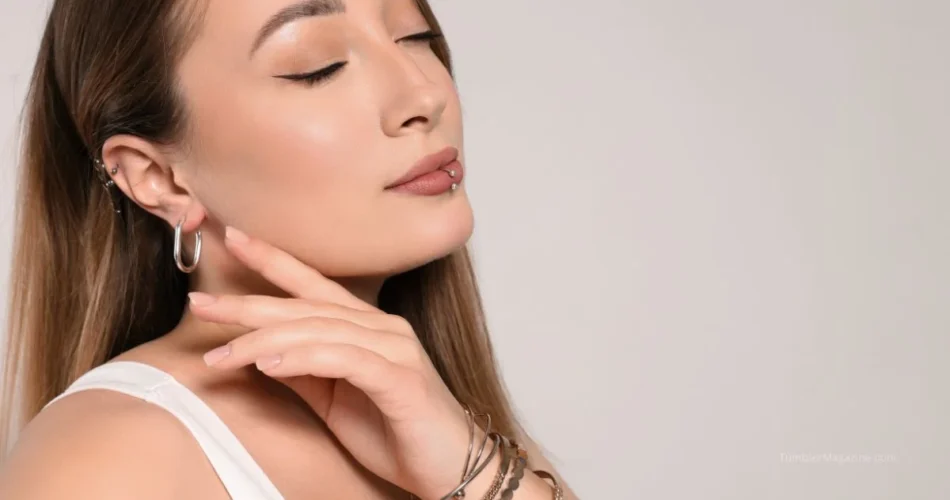Welcome to our comprehensive guide on everything you need to know about daith piercings! If you’re considering this trendy ear piercing or just curious about it, you’ve come to the right place. From what a daith piercing actually is to its potential benefits for migraines, we’ll cover all the essential information you need before taking the plunge. So sit back, relax, and let’s dive into the world of daith piercings together!
Table of Contents
What You Need to Know About Daith Piercings
Curious about daith piercings? They involve piercing the innermost cartilage fold of the ear. The location is close to the pressure point some believe can help alleviate migraines. Many people opt for piercings as a fashion statement or for potential health benefits.
Before getting a piercing, it’s crucial to choose an experienced and reputable piercer. Researching their hygiene practices and previous work is essential. It’s also important to consider the potential pain level and healing process associated with this type of piercing.
When it comes to jewelry options for piercings, there are various choices available, from captive bead rings to curved barbells. Selecting high-quality jewelry that suits your style and anatomy is key for both comfort and aesthetics. Remember that proper aftercare is crucial to prevent infections and promote healing post-piercing!
What Is a Daith Piercing?
Curious about daith piercings? Let’s delve into what they are all about. A daith piercing is a type of ear piercing that goes through the innermost cartilage fold of the ear, creating an edgy and unique look. This specific location can make it stand out from other piercings on the ear.
The name “daith” comes from the Hebrew word for knowledge, reflecting how this piercing can be seen as a symbol of wisdom or understanding in some cultures. It gained popularity due to its aesthetically pleasing placement and potential benefits beyond just style.
While getting a daith piercing may involve some discomfort during the procedure, many find it worth it for the end result. As with any piercing, proper aftercare is crucial to ensure healing goes smoothly and without complications.
If you’re looking to add a bold statement piece to your ear jewelry collection or simply want something different, a piercing could be just what you’re searching for!
Daith Piercings for Migraines
Daith piercings have gained attention for a potential link to migraine relief. While scientific evidence is limited, anecdotal reports suggest that some individuals experience reduced migraine symptoms after getting a piercing. The theory behind this is based on acupuncture principles, as the piercing is said to target pressure points associated with headaches.
It’s important to note that results can vary greatly from person to person, and individual experiences with piercings may differ. Some find significant improvement in their migraines, while others notice no change at all. Before considering a piercing for migraine relief, it’s crucial to consult with a healthcare professional and discuss alternative treatment options.
If you do decide to go ahead with a piercing for migraines, make sure to choose an experienced piercer who uses proper sterilization techniques. Remember that while some people may find relief through this method, it’s not a guaranteed solution for everyone dealing with migraines.
Jewelry for Daith Piercings
When it comes to piercings, choosing the right jewelry is essential. The most common type of jewelry for piercings is a curved barbell or a captive bead ring. These options are comfortable and stylish while allowing for proper healing.
Curved barbells are popular because they follow the shape of the ear, reducing irritation and promoting quicker healing. Captive bead rings have a ball that fits snugly in place, giving a sleek look to your piercing.
For those looking to add some flair, there are various options like gemstones or intricate designs available in different materials such as titanium, stainless steel, or even gold. It’s crucial to choose high-quality materials to avoid any allergic reactions or infections.
Remember that everyone’s style preference and comfort level vary, so take your time exploring different jewelry options until you find the perfect fit for your piercing!
Pain, Healing Time, and Aftercare
After getting a daith piercing, you might experience some discomfort and pain. The level of pain can vary from person to person, but it is generally tolerable for most individuals. The healing time for a piercing typically ranges from 3 to 6 months, during which proper aftercare is crucial.
To promote healing and prevent infection, follow your piercer’s aftercare instructions diligently. It usually involves cleaning the piercing with saline solution or mild soap daily and avoiding touching it with dirty hands. Be gentle when rotating or moving the jewelry to prevent irritation.
During the initial healing period, avoid submerging your piercing in bodies of water like pools or hot tubs to minimize the risk of infection. Additionally, refrain from changing out your jewelry too soon as this can disrupt the healing process.
If you notice any signs of infection such as excessive swelling, redness, or discharge, consult with your piercer or healthcare provider promptly for appropriate treatment. Remember that proper care and patience are key to ensuring a successful healing process for your piercing.
Side Effects and How to Change Out a Daith Piercing
When getting a daith piercing, it’s essential to be aware of potential side effects. Some common side effects include redness, swelling, tenderness, and slight bleeding around the pierced area. These are typically normal reactions as your body adjusts to the new piercing.
To minimize discomfort and reduce the risk of infection, proper aftercare is crucial. Clean the piercing daily with saline solution or mild soap and water. Avoid touching the area with dirty hands and refrain from rotating or playing with the jewelry excessively.
If you experience any unusual symptoms like excessive pain, pus discharge, or prolonged redness/swelling, consult your piercer or healthcare provider immediately. Changing out a piercing should only be done once it has fully healed (typically 6-9 months). Use sterilized tools and follow precise instructions to avoid complications during this process.
Remember that everyone’s healing process varies; patience and attentive care will ensure a successful outcome for your piercing journey.
History and References
The daith piercing has a rich history that dates back centuries, with origins in different cultures around the world. In ancient times, piercings were often seen as symbols of status or spirituality. The piercing specifically gained popularity for its unique placement on the innermost cartilage fold of the ear.
References to this type of piercing can be found in various historical texts and artifacts, showcasing its significance throughout time. As body modification practices have evolved, the piercing has remained a classic choice for those seeking a stylish yet meaningful addition to their look.
Today, celebrities and influencers have helped popularize the piercing even further, making it a trendy choice among people looking to express themselves through body art. Whether you’re drawn to its aesthetic appeal or intrigued by its potential health benefits, getting a piercing is both a fashion statement and an ode to tradition.
Insider Tips and Takeaway
Whether you’re considering getting a piercing or already have one, there are some insider tips and takeaways to keep in mind. First off, make sure you choose a reputable piercer who has experience with piercings specifically. This can help ensure the process goes smoothly and reduces the risk of complications.
When it comes to jewelry selection, opt for high-quality materials like surgical steel or titanium to minimize the chances of irritation or infection. Additionally, consider the size and design of the jewelry carefully as it can impact both comfort and aesthetics.
After getting your daith pierced, follow proper aftercare guidelines provided by your piercer diligently. This includes cleaning the piercing regularly with saline solution and avoiding touching it unnecessarily. Remember that everyone’s healing process is different; be patient and attentive to any signs of infection or discomfort.
Listen to your body throughout the healing period. If something doesn’t feel right or if you experience persistent pain, don’t hesitate to contact your piercer for advice or seek medical attention if necessary.
Earrings and Aftercare Guidelines
When it comes to daith piercings, choosing the right earrings is crucial for both style and comfort. Opt for hypoallergenic materials like titanium or surgical steel to reduce the risk of irritation. Make sure the earrings are snug enough to prevent snagging on clothing but loose enough to allow proper airflow for healing.
After getting your piercing, follow strict aftercare guidelines. Clean the area twice a day with saline solution or a gentle soap, avoiding harsh chemicals that can irritate the skin. Avoid rotating or touching the jewelry excessively to prevent infection. Remember not to remove the jewelry prematurely as it can lead to complications during healing.
Sustainable Jewelry Options
As we’ve explored the world of daith piercings, it’s clear that they’re not just a fashion statement but can also offer potential relief for migraine sufferers. Understanding the piercing process, aftercare, and possible side effects is crucial to ensure a successful and comfortable experience.
When it comes to selecting jewelry for your piercing, opting for sustainable options can be both stylish and environmentally conscious. Look for materials like stainless steel, titanium, or gold from reputable sources to minimize environmental impact.
Remember to always prioritize proper aftercare practices to promote healing and reduce the risk of infections. Regularly clean your piercing with saline solution and avoid touching it with dirty hands.
With these guidelines in mind, you can confidently embark on your piercing journey knowing that you have all the information you need to make informed decisions about your body modification choices. Embrace this unique form of self-expression while prioritizing sustainability and well-being.

